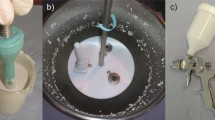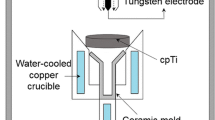Abstract
The chemical reaction between mold material and titanium melt during investment casting was studied intensively. However, the influence of residue gas in ceramic mold on interface reaction remains unclear. In this investigation, the effect of residue gas in Y2O3–silica sol shell mold on interface reaction during Ti–6Al–4V alloy investment casting was investigated. Two groups of shell molds were prepared by adding different kinds of pore formers, i.e., spherical starch particles or nylon fibers, respectively. Ti–6Al–4V alloy was cast under vacuum by gravity casting through cold crucible induction melting (CCIM) method. Porosity of different shell molds was measured based on Archimedean method. Scanning electron microscopy (SEM) and energy-dispersive X-ray spectroscopy (EDS) were employed to characterize the micromorphology and composition of the reaction area, respectively. White light interferometer (WLI) was used to obtain the surface topography of the shell mold. The results show that the direct chemical reaction is very weak for all specimens. The release of residue gas in closed pores is the key factor influencing surface defects. However, open pores make nearly no difference on the interface reaction.
Access this article
We’re sorry, something doesn't seem to be working properly.
Please try refreshing the page. If that doesn't work, please contact support so we can address the problem.











Similar content being viewed by others
References
Saha RL, Jacob KT. Casting of titanium and its alloys. Def Sci J. 2014;36(2):121.
Nastac L, Gungor MN, Klug KL, Tack WT. Advances in investment casting of Ti–6Al–4V alloy: a review. Int J Cast Met Res. 2006;19(2):73.
Sung SY, Kim YJ. Alpha-case formation mechanism on titanium investment castings. Mater Sci Eng, A. 2005;405(1):173.
Kumar S, Narayanan TNS, Raman SGS, Seshadri SK. Thermal oxidation of Ti6Al4V alloy: microstructural and electrochemical characterization. Mater Chem Phys. 2010;119(1–2):345.
Liu AH. The interfacial reaction law and micromechanism between titanium alloy melts and ceramic mould. Harbin: Harbin Institute of Technology; 2007. 30.
Cotton JD, Clark LP, Phelps HR. Titanium investment casting defects: a metallographic overview. JOM. 2006;58(6):13.
Boettinger W, Williams J, Coriell M, Kattner E, Mueller S. Alpha case thickness modeling in investment castings. Metall Mater Trans B. 2000;31(6):1419.
Lin KF, Lin CC. Interfacial reactions between zirconia and titanium. Scr Mater. 1998;39(10):1333.
Kim MG, Kim SK, Kim YJ. Effect of mold material and binder on metal-mold interfacial reaction for investment casting of titanium alloys. Mater Trans. 2002;43(4):745.
Jerry CL, Anthony JF, Eoin JB. Inert calcia facecoats for investment casting of titanium and titanium–aluminide alloys. US Patent; 5766329.1998.
Cheng X, Sun XD, Yuan C, Green NR, Withey PA. An investigation of a TiAlO based refractory slurry face coat system for the investment casting of Ti–Al alloys. Intermetallics. 2012;29:61.
Peng XM, Wu AR, Dong LJ, Tao YR, Gao WG, Zhou XL. Stability of NiCrAlY coating/titanium alloy system under pure thermal exposure. Rare Met. 2017;36(8):659.
Neto RL, Duarte TP, Alves JL, Barrigana TG, Da SL. The influence of face coat material on reactivity and fluidity of the Ti6Al4V and TiAl alloys during investment casting. Proc Inst Mech Eng, Part L. 2017;231(1-2):38.
Holcombe CE, Serandos TR. Consideration of yttria for vacuum induction melting of titanium. Metall Trans B Process Metall. 1983;14(3):497.
Gao M, Cui RJ, Ma LM, Zhang HR, Tang XX, Zhang H. Physical erosion of yttria crucibles in Ti–54Al alloy casting process. J Mater Process Technol. 2011;211(12):2004.
Lapin J, Gabalcova Z, Pelachova T. Effect of Y2O3 crucible on contamination of directionally solidified intermetallic Ti–46Al–8Nb alloy. Intermetallics. 2011;19(3):401.
Tetsui T, Kobayashi T, Ueno T, Harada H. Consideration of the influence of contamination from oxide crucibles on TiAl cast material, and the possibility of achieving low-purity TiAl precision cast turbine wheels. Intermetallics. 2012;31:274.
Zhao ET, Kong FT, Chen YY. Effect of different primary coating materials and mold temperatures on fluidity of high-temperature titanium alloy. Proc Inst Mech Eng, B J Eng Manuf. 2012;226(11):1862.
Wei YM, Hu KH, Lu ZG. Effect of SiO2 concentration in silica sol on interface reaction during titanium alloy investment casting. China Foundry. 2018;15(1):23.
Kostov A, Friedrich B. Predicting thermodynamic stability of crucible oxides in molten titanium and titanium alloys. Comp Mater Sci. 2006;38(2):374.
Wei YM, Lu ZG, Wu GP, Long XQ. Reaction between Ti–6Al–4V and Y2O3–SiO2 based face shell for investment casting. Rare Met. 2016;35(12):901.
Cheng X, Yuan C, Blackburn S, Withey PA. The study of the influence of binder systems in an Y2O3–ZrO2 face coat material on the investment casting slurries and shells properties. J Eur Ceram Soc. 2014;34(12):3061.
Guo X, Wei YM, Lu ZG. Reaction of titanium investment castings made by Zr (CH3COO)2–Y2O3 shell. Rare Met. 2017;36(6):465.
CamPbell J. Casting (Second Edition). Li DZ, Li YY, translated. Beijing: Science Press, 2011.16.
Srivastava D, Chang IT, Loretto MH. The effect of process parameters and heat treatment on the microstructure of direct laser fabricated TiAl alloy samples. Intermetallics. 2001;9(12):1003.
Malan AG. Investigation into the continuum thermodynamic modelling of investment casting shell-mould drying. Wales Swansea: University of Wales Swansea; 2003. 10.
Mi J, Harding RA, Wickins M, Campbell J. Entrained oxide films in TiAl castings. Intermetallics. 2003;11(4):377.
Owen EA, Davies DA. An X-ray study of the mutual solid solubilities of zinc and cadmium. Br J Appl Phys. 1965;16(9):1291.
Baghani A, Bahmani A, Davami P, Varahram N, Shabani MO. Application of computational fluid dynamics to study the effects of sprue base geometry on the surface and internal turbulence in gravity casting. Proc Inst Mech Eng, L J Mater Des Appl. 2015;229(12):106.
Wu XH, Huang A, Hu D, Loretto MH. Oxidation-induced embrittlement of TiAl alloys. Intermetallics. 2009;17(7):540.
Acknowledgements
This study was financially supported by the National Natural Science Foundation of China (No. 50875144).
Author information
Authors and Affiliations
Corresponding author
Rights and permissions
About this article
Cite this article
Wei, YM., Lu, ZG., Li, XY. et al. Interface reaction during titanium alloys investment casting by residue gas in ceramic mold. Rare Met. 38, 327–335 (2019). https://doi.org/10.1007/s12598-018-1138-3
Received:
Revised:
Accepted:
Published:
Issue Date:
DOI: https://doi.org/10.1007/s12598-018-1138-3




